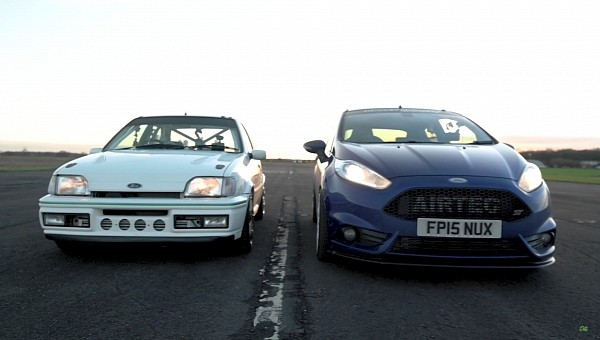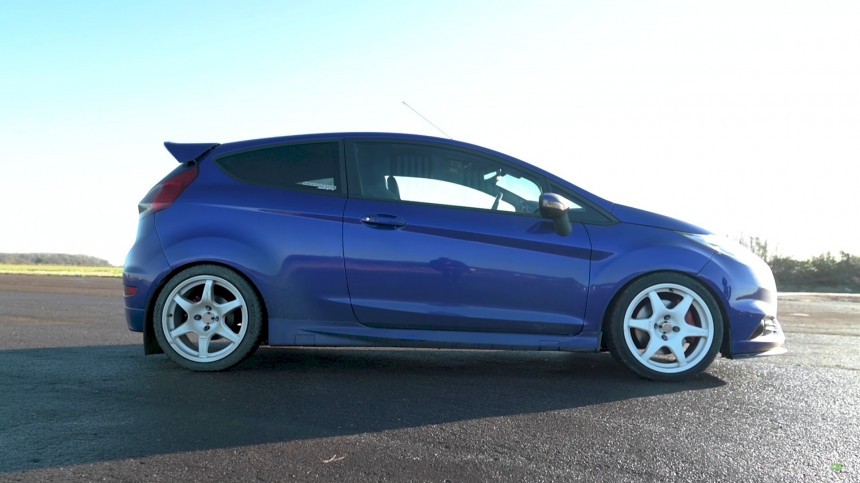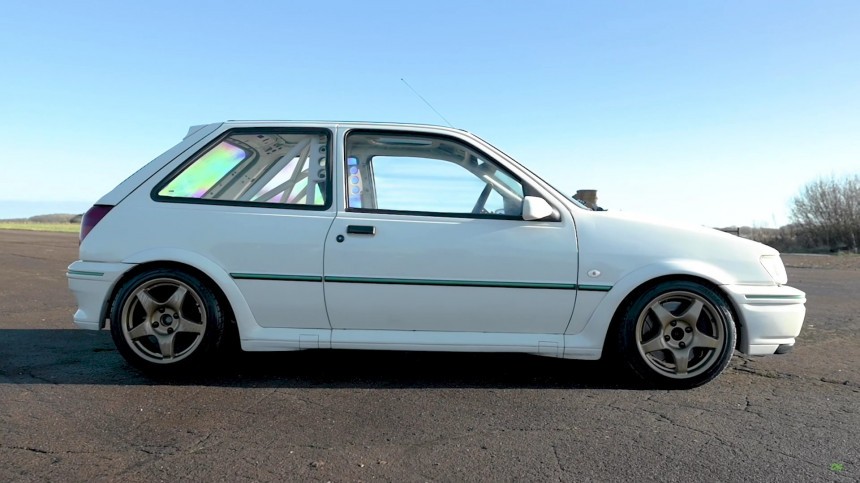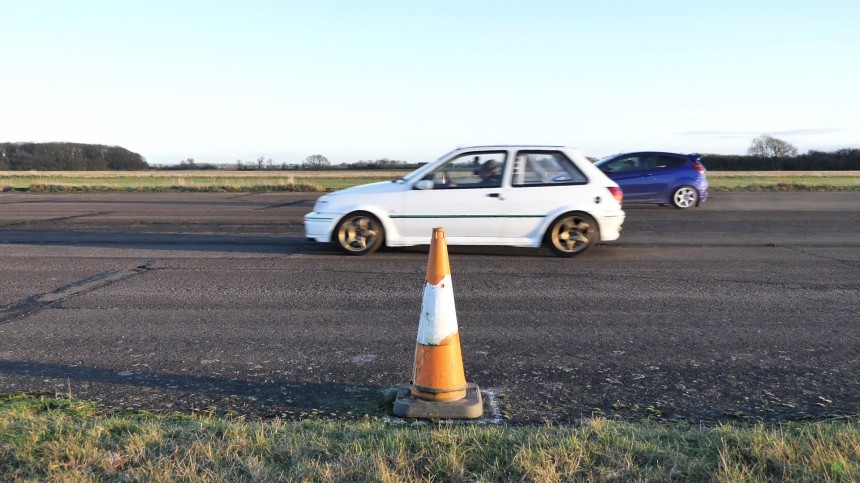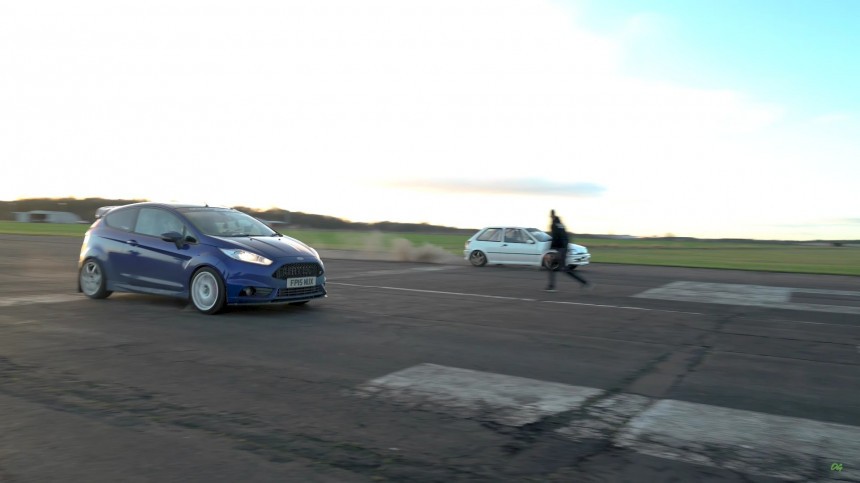Old school or young blood - which would be faster in a race that extends down a straight strip of concrete one-fourth of a mile long? The question needs some supplementary information, as drag racing is much more complicated than it looks from the side.
Let's narrow it down – for the sake of sporting mathematics: two Fords, similar in shape, European models, with mechanical refinements under their hoods. Namely, the small Fiesta model is represented by two of its most well-known variants (in the piston-worshipping circles).
The Rally Sport Turbo from 1992 goes up against the Sports Technology bad boy from 2015. Or, to put it acronymically, RS versus ST, a clash of generations staged by the English YouTubers from Officially Gassed. Turbo treatments under both hoods, a vast difference in power – and weight – make the camshaft equation more exciting.
On paper, the two competitors are evenly matched, but drag races are held on tarmac. Better yet, here are the facts. In the Blue corner, we have a 2015 Mk VII Ford Fiesta ST 180. The engine is the original 1.6-liter, four transversally aligned cylinders. The additions list opens with a new turbocharger and ends with the three-inch (75-millimeter) turbo back exhaust.
Between the two tuning upgrades, a competition clutch, an induction kit, and an oversized intercooler combine their powers to a grand total of 310 hp (314 PS) and 319 lb-ft (432 Nm). The car's driver and owner is also the mechanic that tuned this Fiesta. Incidentally, the little Ford is also his regular day-to-day vehicle.
Front-wheel drive (courtesy of the factory-installed six-speed manual gearbox and open differential) is the way forward for this ST. With a body mass of 1,150 kg (2,535 lbs.), this daily driver of a racer bet it all on its 269 hp/ton punching power (273 PS/ton).
We now jump back in time some 13 years from the birth of this Mk VII Fiesta and land in 1992—a time when cars were very different from the precise computational results of modern-day automotive technology.
The Mk III generation of the Fiesta saw the light of day in 1989, and the RS Turbo version came out one year later. By 1992, the sporty model – crippled in sales figures by several handling issues and insurance quotas – was retired.
One of the last-year examples received a massive upgrade in the go-fast sector and is now sitting in the white corner, challenging its four-generation-younger great-grandson. The RS Turbo got a 2.0-liter inline-four (Ford's own Zetec powerplant from the early 90s) instead of its stock 1.6-liter four-banger and a fistful of tuning.
The power rating is a nifty 270 hp (274 PS) and a tire-shredding 280 lb-ft (380 Nm) – all sent to the front wheels through a five-speed manual. These meager numbers would fail to make an impression on gearheads of 2023, more accustomed to the vicinity of a threefold horsepower rating.
But the old Ford has the weight ace up its gutted sleeve: 850 kg (1,874 lbs) suddenly fades out the net horsepower advantage of the stubbier Mk VII. The RS swiftly becomes the bookmaker's favorite with an overall power-to-weight ratio of 317 hp/ton (322 PS/ton).
An important sidenote is needed here: the three-decade-young Ford is running on low boost in this race, as it only came out from the shop a month before the sprint. To make matters more intense, the driver did not have a test drive in his car before this race.
The die is cast, and the roll race is the first showdown of the day at the damp track where Oficially Gassed hold their regular weekly fun-filled challenges. Both cars give it all on the 1,320-foot run with the turbos in automatic rapid-fire mode. The lightweight RS quickly takes the win in all three stages (but the newer Fiesta experienced a floppy gear shift in the second run and forfeited).
Round two – the classic drag race – is even more dramatic: the MK III's older tech is as flamboyant as you'd expect it to be. Tires spinning, rubber smoking, and grip slipping – that was the way back in the 90s. The 1992 Fiesta RS falls behind the ST and stays there for the entire first standing quarter-mile dash.
Turbo lag or not, the second run is better paced, with both cars going neck and neck for a brief instance. Sadly for the gasoline-induced adrenaline rush hunters, the RS's fuel system gives in, and the vehicle abandons the game completely. This is where we should remember that it is an untested build, and sometimes mishaps happen.
Neither car managed to peak beyond 124 mph (200 kph) trap speed in any of the races, so a 62-124 mph (100-200 kph) is unavailable. The best the two Fords could offer was 109.85 mph (176,75 kph) – on the ST – and 110 mph (176.99 kph) on the RS side.
As for the standard 440-yard sprint times, the 2015 Fiesta ST comes on top by around half a second: 13.71 seconds versus 14.28. Notably, the RS achieved its best score in the quarter mile at a lowly 86.66 mph terminal velocity (139.44 kph). Its best top-speed run (110 mph) stopped the timer at the 14.42-second mark after leaving parallel tire marks on the track due to an abundance of wheel spin off the line.
The Rally Sport Turbo from 1992 goes up against the Sports Technology bad boy from 2015. Or, to put it acronymically, RS versus ST, a clash of generations staged by the English YouTubers from Officially Gassed. Turbo treatments under both hoods, a vast difference in power – and weight – make the camshaft equation more exciting.
On paper, the two competitors are evenly matched, but drag races are held on tarmac. Better yet, here are the facts. In the Blue corner, we have a 2015 Mk VII Ford Fiesta ST 180. The engine is the original 1.6-liter, four transversally aligned cylinders. The additions list opens with a new turbocharger and ends with the three-inch (75-millimeter) turbo back exhaust.
Front-wheel drive (courtesy of the factory-installed six-speed manual gearbox and open differential) is the way forward for this ST. With a body mass of 1,150 kg (2,535 lbs.), this daily driver of a racer bet it all on its 269 hp/ton punching power (273 PS/ton).
We now jump back in time some 13 years from the birth of this Mk VII Fiesta and land in 1992—a time when cars were very different from the precise computational results of modern-day automotive technology.
One of the last-year examples received a massive upgrade in the go-fast sector and is now sitting in the white corner, challenging its four-generation-younger great-grandson. The RS Turbo got a 2.0-liter inline-four (Ford's own Zetec powerplant from the early 90s) instead of its stock 1.6-liter four-banger and a fistful of tuning.
The power rating is a nifty 270 hp (274 PS) and a tire-shredding 280 lb-ft (380 Nm) – all sent to the front wheels through a five-speed manual. These meager numbers would fail to make an impression on gearheads of 2023, more accustomed to the vicinity of a threefold horsepower rating.
An important sidenote is needed here: the three-decade-young Ford is running on low boost in this race, as it only came out from the shop a month before the sprint. To make matters more intense, the driver did not have a test drive in his car before this race.
The die is cast, and the roll race is the first showdown of the day at the damp track where Oficially Gassed hold their regular weekly fun-filled challenges. Both cars give it all on the 1,320-foot run with the turbos in automatic rapid-fire mode. The lightweight RS quickly takes the win in all three stages (but the newer Fiesta experienced a floppy gear shift in the second run and forfeited).
Turbo lag or not, the second run is better paced, with both cars going neck and neck for a brief instance. Sadly for the gasoline-induced adrenaline rush hunters, the RS's fuel system gives in, and the vehicle abandons the game completely. This is where we should remember that it is an untested build, and sometimes mishaps happen.
Neither car managed to peak beyond 124 mph (200 kph) trap speed in any of the races, so a 62-124 mph (100-200 kph) is unavailable. The best the two Fords could offer was 109.85 mph (176,75 kph) – on the ST – and 110 mph (176.99 kph) on the RS side.
